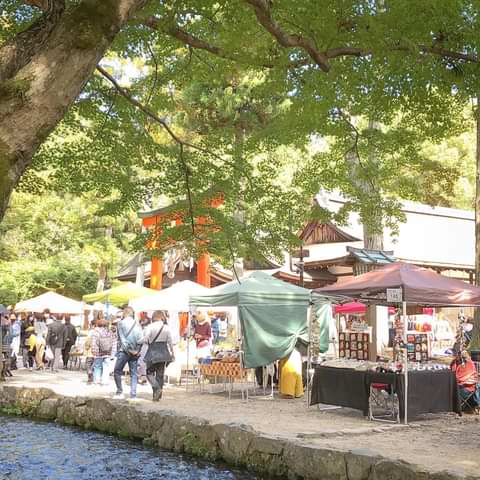Four Seasons in Japan
Autumn 秋
Chapters 8 〜 14
Day 8 - Himeji
Itinerary of the day
Photo gallery
Typical products and souvenirs
Sakura kōbo sakè 桜酵母酒
This “cherry sake” is a typical souvenir of the city of Himeji. It is a sake produced with Sakura Kōbo, the yeast obtained from the flowers of the sakura that grow numerous in the gardens of the castle Himeji-jō.
To be eaten cold, it has a sweet and balanced aroma with a high acidity. The same glass bottle in which it is sold, reminiscent of the castle walls, is a collector’s souvenir. A distillery that sells it is the Tatsuriki.

Himeji-koma 姫路独楽
The Himeji-koma are wooden spinning tops produced in this area for more than 100 years. They were a very popular toy among children, thanks to the excellent ability to stay in balance for a long time.
Painted by hand, today they are still widely used as decorations of folk art, souvenirs and small gifts to be exchanged on the occasion of the New Year.
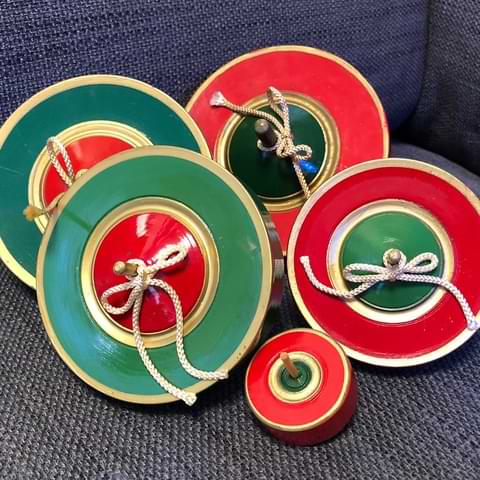
Myōchin hibashi-fūrin 明珍火箸風鈴
The fūrin are wind bells made of glass or cast iron that hang under the porches mainly in summer, producing a pleasant sound in the wind.
Unlike the most common fūrin, the hibashi-fūrin made by the Myōchin family of Himeji consist of four metal chopsticks for braziers.
For their elegance and design they are also used as elements of interior design in homes. On the official website of the Myōchin family you can also buy them online.
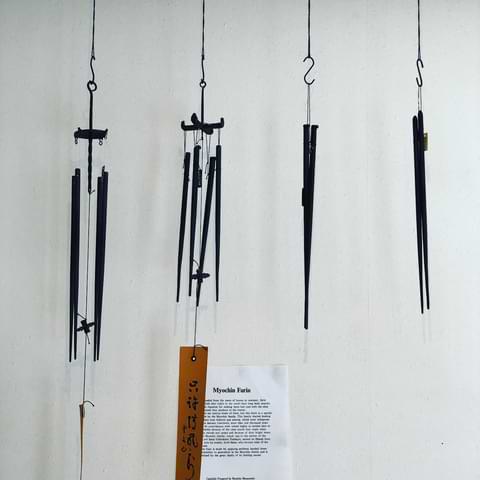
Himeji-hariko 姫路張子
Hariko is a technique of working washi paper to create toys, animal statues and festival masks.
This technique is typical of the Himeji area and the prices of these objects are very low and easy to carry, therefore excellent as souvenirs.
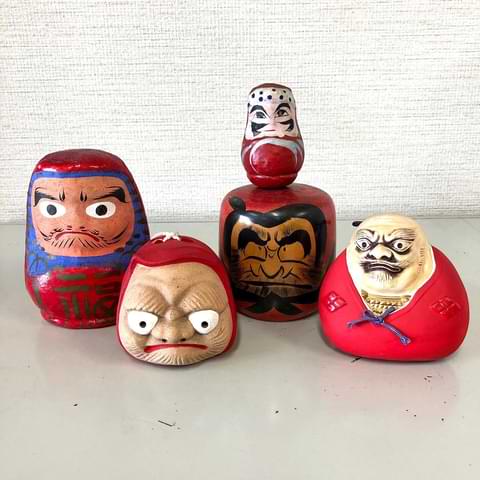
Hime kawa-zaiku 姫革細工
Hime’s leather objects are another typical handmade souvenir of Himeji. Until the Sengoku era, samurai armor, saddles, harnesses and bridles for horses were mainly made of leather, and it is believed that in the area of Himeji the processing of these leather began.
Today you can buy different products so processed, such as wallets, bags and other everyday items. In particular, Hime leather is known for having pretty bright colors, ranging from red, white, blue and pink and to accommodate designs and decorations that embellish objects making them real works of art.
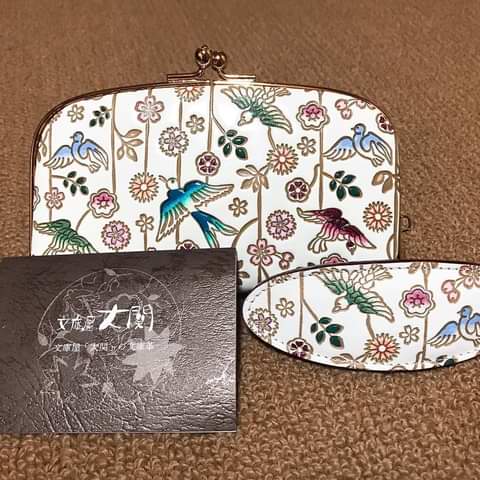
Useful links
Day 9 - Okayama & Takamatsu
Itinerary of the day
Photo gallery
Typical products and souvenirs
Bonsai 盆栽
In Takamatsu, the city that houses the largest pine garden in Japan, many nurseries sell pine bonsai, such as those in Kokubunji and Kinashi, west of Takamatsu, the main production area of pine bonsai. A small shop is also present inside the Ritsurin-koen garden.
The most common pine variety in Japan is the Kuromatsu (Pinus thunbergiana), or black pine, mainly found in the coastal areas of Honshū Island. Characterized by a rough and dark bark and rough and pointed leaves, the Kuromatsu is called ‘Omatsu’, male pine, and is very resistant.
On the contrary, the Akamatsu pine (Pinus densiflora), or red pine, is instead called ‘Mematsu’, female pine, as it has delicate, long and thin leaves with an equally slender trunk. Its bark tends to become reddish with age and is mainly found in mountainous regions.
The region’s pine bonsai trees have a reputation for being difficult to grow, as they grow in a particular, well-drained soil. In case of purchase it is recommended to inquire at the store and the airport for export.
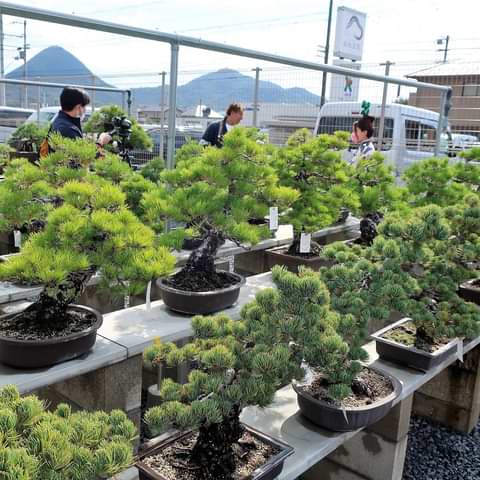
Sanuki udon 讃岐うどん
Created 1200 years ago in present-day Kagawa Prefecture, once called Sanuki region, these udon are characterized by a tubular and thick shape, and are among the three most famous udon in Japan.
They can be bought packaged, dry or fresh, in various stores especially in Takamatsu. In the city there are many restaurants that adopt the do-it-yourself formula where the customer, received the bowl of steaming spaghetti, can finish cooking in special pots and choose the accompanying ingredients, one of these is Chikusei.
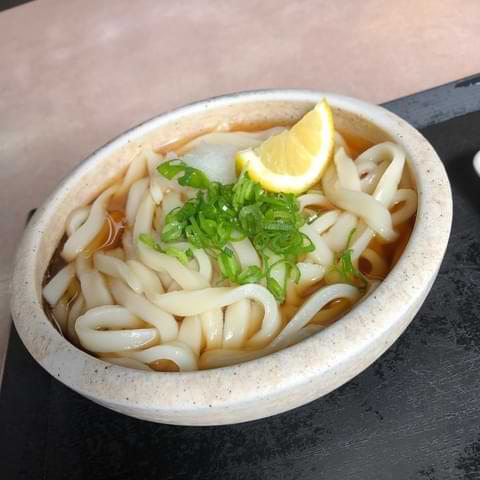
Sanuki kagari-temari 讃岐かがり手まり
Introduced from China during the Heian period, these craft spherical objects were used by children as toys in the game of Otedama, the top launch of bean bags, particularly in the early days of the year.
With the passage of time, they have become refined decorations where colorful and interwoven threads create unique geometric designs. Today they are sold as keychains, or home decorations.
The Sanuki Kagari-temari have beautiful geometric patterns and are created using a dough called Sanuki Sanpaku, made of cotton, salt and sugar, typical of the prefecture. The yarn is dyed with vegetable dye, kusaki-Zome, and the threads are woven one by one.
The shop of Sanuki Kagari Temaki of Eiko Araki is a landmark of these craft products in the city of Takamatsu, also organizing workshops.
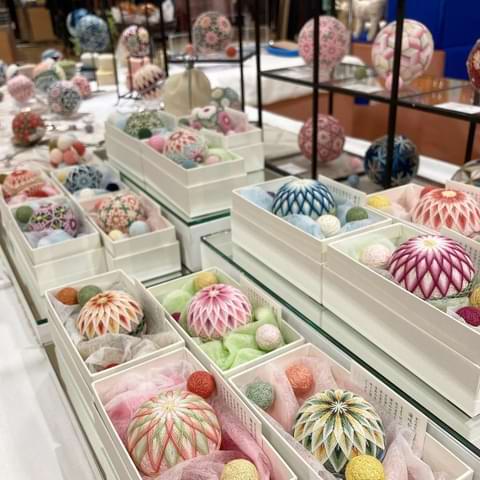
Sanuki Chōchin 讃岐提灯
Sanuki Chōchin are ancient lanterns that originated around the tenth century, introduced from China by the Buddhist monk Kōbō Daishi as votive offerings during the pilgrimage between the 88 temples of Shikoku.
Initially elongated, with time these lanterns have taken on a wide variety of shapes. They are very valuable because they are hand painted with colorful designs and patterns.
In Kagawa, these lanterns are made by Masanobu Miyoshi, the eleventh owner of the Miyoshi Shōten store in Takamatsu. He also creates the Kaomise Chōchin, lanterns with coats of arms of actors that are staged at the Konpira Grand Theatre during the annual kabuki theatre show Shikoku Konpira Kabuki Ōshibai. Workshops are also held in his shop to create these lanterns.
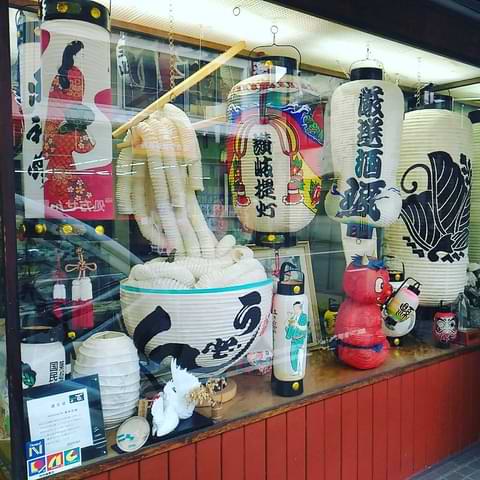
Aji-seki 庵治石
The Aji stone is a granite originating from the district of Mure Aji, east of Takamatsu. Characterized by a finely structured surface and the same hardness of quartz that makes it weatherproof, it is also called “granite diamond”. These features allow elaborate carvings and the sculptor Isamu Noguchi, famous throughout the world, was long attracted to this stone.
Present in several variations of color and quality, thanks to its beauty and robustness it has been used as a first-class stone material for tombs or tōrō lanterns in temples and gardens.
Today, in the city of Takamatsu, several gift shops such as Town’s Schule 963 offer handicrafts made with this stone.
Thanks to the AJI PROJECT, many stone artisans have specialized in the difficult processing of this hard stone to make small and beautiful objects of furniture. Workshops can also be held in several shops, such as the Nakayama Stone Studio.
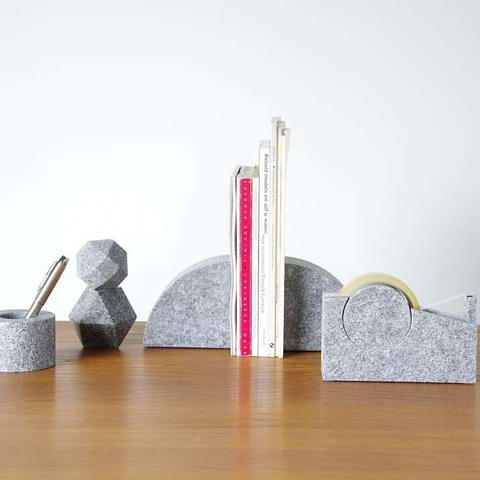
More souvenirs
In addition to those already presented, in Takamastu you can find many other typical products of the prefecture, sold both in specialized stores and in stores of traditional handicrafts such as IKUNAS:
- Products in lacquer of Kagawa
- Sanuki Okedaru, hinoki cypress wood containers with cherry or birch lid
- Takamatsu Yomeiri Ningyō, traditional clay dolls of the city painted by hand
- Ranma Chokoku, hand carved and carved wooden products
- Takamatsu Wagasa, traditional Japanese umbrellas
- Koshiki Datami, small traditional tatami of various forms
- Rihei-yaki potteries
- Botaori, textile fabrics of the city
- Sanuki Shishigashira, wooden lion heads
Useful links
Day 10 - Niihama
Itinerary of the day
Photo gallery
Typical products and souvenirs
Fuguzaku ふぐざく
Fuguzaku is a characteristic and prized dish of Niihama usually available from October to March, and consists of the combination of puffer fish fillet and skin, lima fish liver, chopped spring onions, sauce dressing ponzu and momiji-oroshi, a sauce made from daikon and spicy spices. The refreshing taste of this dish makes it an excellent appetizer that goes well with sake.
Hamacho is the famous restaurant considered the birthplace of fuguzaku, but in autumn and winter this dish appears on the tables of several restaurants, especially those along the coastal area and the harbor. In addition, fuguzaku is the protagonist of Arai-no-Imodaki, an annual early autumn event along the banks of the River Kokuryō-gawa where people gather in the evening to eat typical dishes outdoors.
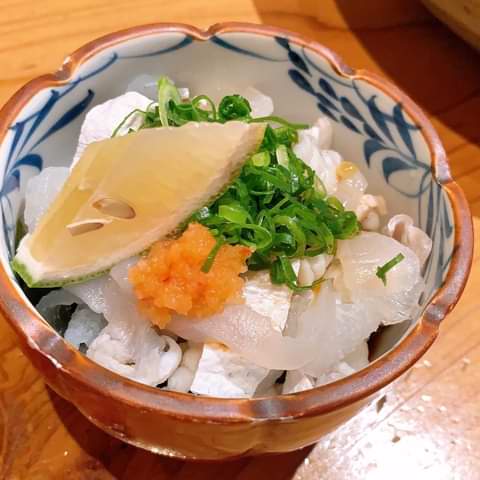
Shichifuku-imo 七福芋
Schichifuku-imo white potatoes, whose name means “seven potatoes of fortune”, are a traditional product of the island of Ōshima, opposite the coast of Niihama.
Also called “ghost potato” or “miracle potato” because of its very reduced yield, it has a whitish skin and a sugar content equal to that of melons.
In the city, several shops sell food, such as sweets, snacks, and drinks made from this vegetable, such as Shichifuku-imo Shōchū.
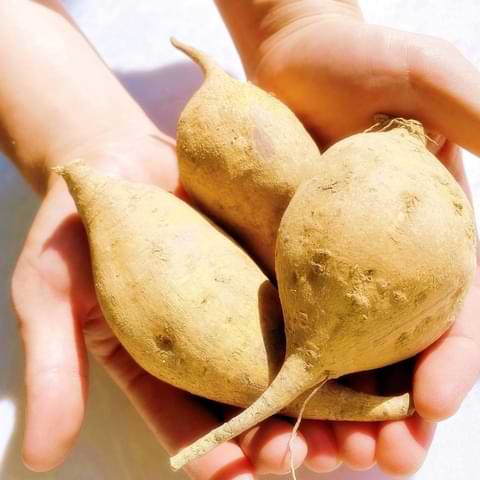
Niihama-garasu 新居浜硝子
Niihama glass is a very appreciated product and is mainly used in the production of glasses.
The glass products are made using a rock, chlorine shale, made from the mines Besshi, today historical and tourist site in the vicinity of the city. The iron contained in this mineral gives the typical intense green color to the glass.
Glass products are a popular souvenir in the Tenkū-no-Mori mining area of Besshi, while the Akagane museum, the city’s main museum, occasionally holds seminars on the creation of glass accessories and sandblasting.
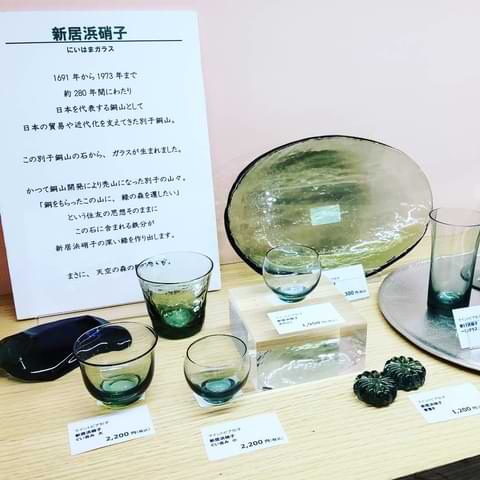
Zanki ざんき
The zanki of Niihama is a dish made of boneless chicken very similar to karāge but in an even crunchier guise. In the city several restaurants offer this specialty.
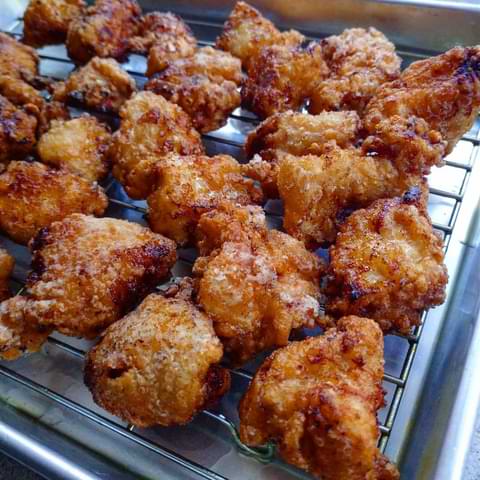
Sweets and liqueurs with citrus
Due to the mild maritime climate, citrus plantations are widespread in the Ehime region.
From them are obtained several typical products such as “Lemon Cake”, a popular dessert of Niihama very refreshing taste made with lemon peel in a soft dough of eggs and honey and covered with white chocolate lemon. In Niihama there is an official shop that sells this cake and other delicacies based on local citrus.
Equally famous is the liqueur made from Maana Mikan of Ehime Prefecture.
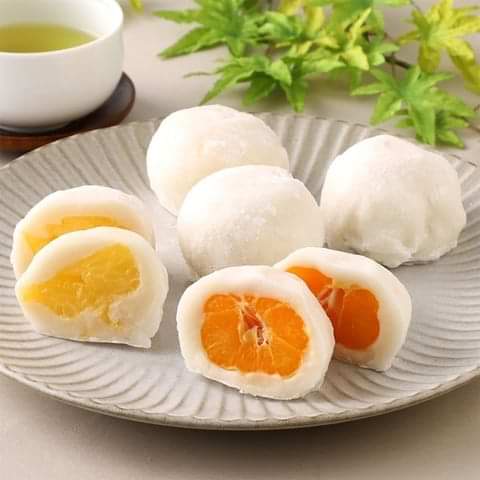
Useful links
We really hope that reading is thrilling you!
If so, we would be very grateful if you could leave a star rating or a short review to the book on amazon, not having a publishing house behind it would be of great help!
Also, don’t hesitate to let us know your impressions on Instagram and Facebook using the hashtag #fourseasonsinjapan or by tagging @cuor.di.manju in your posts/stories.
Day 11 - Beppu
Itinerary of the day
Photo gallery
Typical products and souvenirs
Pomelo ポメロ and Kabosu カボス
In the Beppu area there are two seasonal citrus fruits widely used also in the aromatization of sweets and candies. The fruit of kabosu (Citrus sphaerocarpa) is sold at Umi Jigoku from late August to late October, while the pomelo (Citrus maxima) is sold to Tatsumaki Jigoku from late December to late March.
Kabosu, similar to yuzu, is very popular in the kitchen for flavoring sashimi and grilled fish. Its kabosu juice is used in a wide range of products including condiments, snacks, wagashi and alcoholic beverages.
The pomelo is an attraction also inside the “zabon” hot springs: it is a custom of the city according to which when winter arrives, the pomelo are brought to the surface in some hot springs to enjoy the scent. It is said that in the past many hot springs had pomelos inside them, but since they have become a specialty, people began to eat them, causing an excessive buoyancy of skins that led to their elimination.
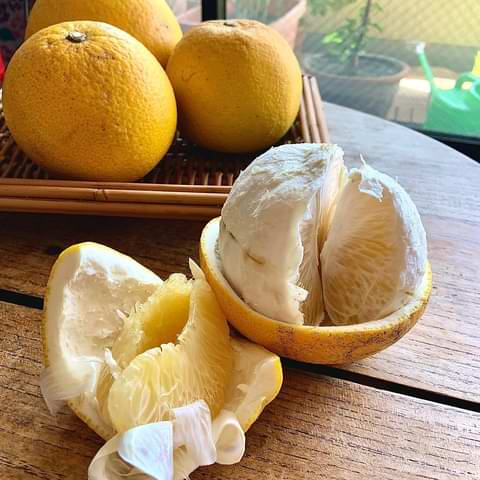
Dango-jiru だんご汁
Dango-jiru, literally “gnocchi soup”, is a typical dish of Ōita Prefecture in which the dough is obtained by kneading wheat flour and spreading it in wide strips that vaguely resemble kishimen udon. This is then served in soup with vegetables and chicken.
It was once commonly consumed as a substitute for rice when it was scarce and, since Ōita Prefecture has a territory not suitable for rice cultivation, cultivation of cereals such as wheat has been popular for centuries and has led to the development of dishes like this.
Among the restaurants where you can try this regional dish there is Bungo Chaya in the station or the restaurant Cafeteria Umi in the Umi Jigoku, which also offers a spicy version.
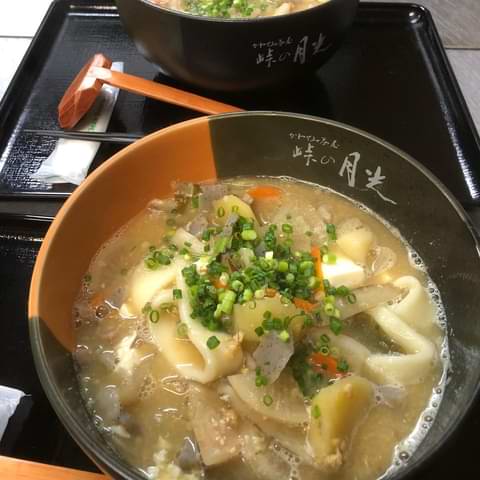
Hells thermal products
Beppu offers many products for cosmetics based on mud and thermal waters. Often the same Jigoku have small internal stores specializing in the sale of such products.
At the Umi Jigoku there is a souvenir shop selling the Enman-no-Yu bath salt obtained from the hot springs from the sea hell.
A shop that offers a wide variety of mud and thermal products for skin care and not only is located within the Tatsumaki Jigoku.
At the Chinoike Jigoku is sold Chinoike unguent, a cream for the treatment of skin whose use dates back to the period of World War II. The mineral-rich Chinoike thermal water is also sold here.
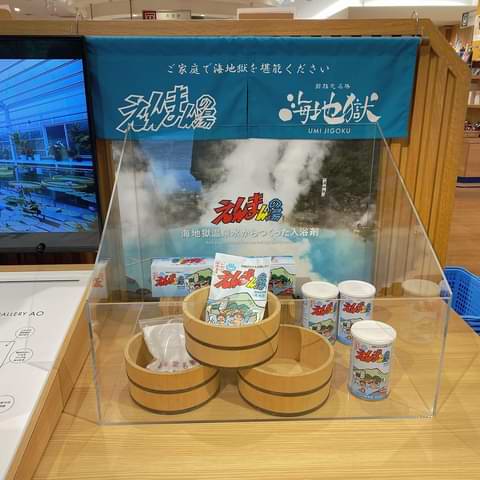
Beppu reimen 別府冷麺
Like many Japanese dishes, Beppu reimen is not native to Japan but rather to continental countries, particularly Manchuria. The original recipe was modified according to the Japanese taste and today the taste is quite characteristic. The noodle is served cold inside a meat broth with miso, kimchi and other vegetables.
The noodle is made from buckwheat flour but, unlike soba, it is more chewy and has the same thickness as classic noodles. The broth is cold and clear, perfect in summer, while in winter are also served hot reimen called onmen.
Each restaurant serves its own reimen version at Beppu, which makes each of them a treat for the palate!
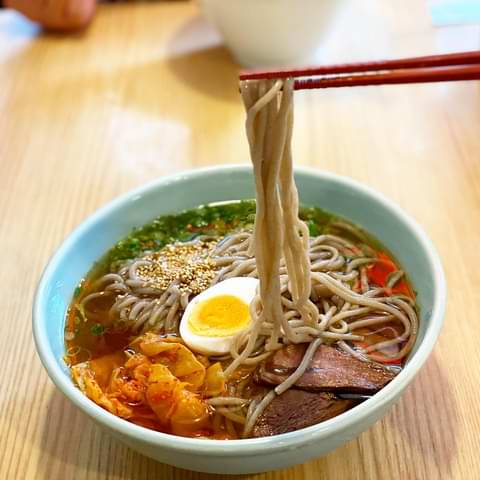
Jigoku-mushi 地獄蒸し
The Jigoku-mushi cuisine is a style of cooking that uses the steam of natural hot springs to cook food, one of the most famous customs of the spa town par excellence.
In Beppu there are several stations where you can taste products cooked with this method, in particular eggs. Some of these can be found along the city streets or at some of the hells.
At Oniishibōzu Jigoku there is a shop where you can eat delicious Xiaolongbao ravioli, eggs, puddings and okowa, or rice cooked with mushrooms and various vegetables.
At the shopping area of the Kamado Jigoku are sold mainly eggs, puddings and cobs, but also specialties such as the Matcha Ishigaki-manjū.
If you want to experience this cooking, it is famous in the city the restaurant Jigoku-mushi Kōbō Kannawa where customers can cook themselves meat, fish and vegetables using this technique. The venue is so popular that on weekends and public holidays the waiting time can get up to two or three hours, but you can in while enjoying the free foot baths or strolling around the onsen nearby.
Chinetsu Kankō Rabo Enma offers an equally incredible experience of do-it-yourself thermal cuisine, while the geothermal center to which the restaurant is attached offers several activities, also related to the realization of handicrafts.
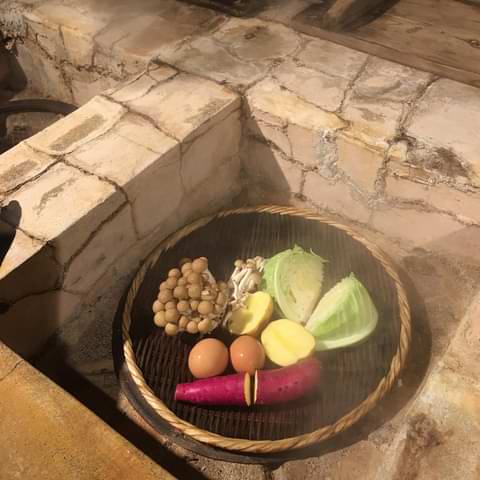
Useful links
Day 12 - Beppu & Fukuoka
Itinerary of the day
Photo gallery
Typical products and souvenirs
Hakata rāmen 博多 ラーメン
Hakata rāmen originated in the ancient city of Hakata and differs from broths made from salt or soy sauce because of the full-bodied pork broth, tonkotsu. To obtain this broth, the pork is boiled, together with the other ingredients, for a time between 6 and 18 hours depending on the restaurant, making sure that the meat and bones release the umami.
As for the accompanying seasonings, the most common are the chāshū pork slices, green onions, eggs and kikurage mushrooms.
It is one of the most famous rāmen styles in Japan, and has recently become popular in the West thanks to the spread of chains such as Ippūdō and Ichiran, with outlets in America, France, England and many other countries.
The best place to enjoy the Hakata rāmen in Fukuoka is at the iconic yatai of the city, especially those along the River Naka-gawa with a very suggestive atmosphere, while at the Rāmen stadium in Canal City you can taste many different variations of tonkotsu broth in one place.
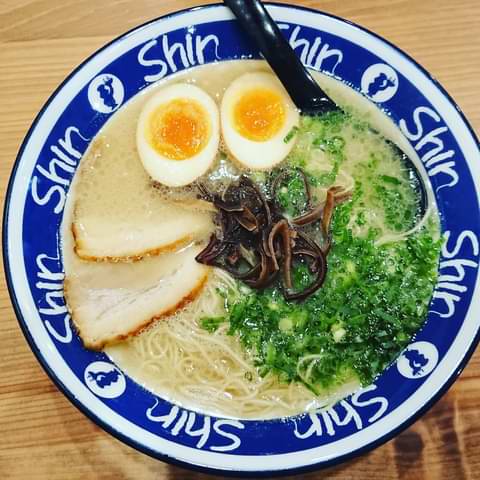
Mentaiko tamagoyaki 明太子 卵焼き
Mentaiko tamagoyaki is a popular dish in Fukuoka, often served at yatai. The soft Japanese-style omelette, tamagoyaki, is rolled around a mentaiko filling, Korean spicy marinated Alaska Pollack eggs.
The mentaiko, sometimes also called karashi mentaiko, is the spicy version of the normal tarako and is an original recipe of Hakata, which later became common throughout the country. In fact, it can be found, all over Japan, as stuffing for onigiri and seasoning in many other dishes.
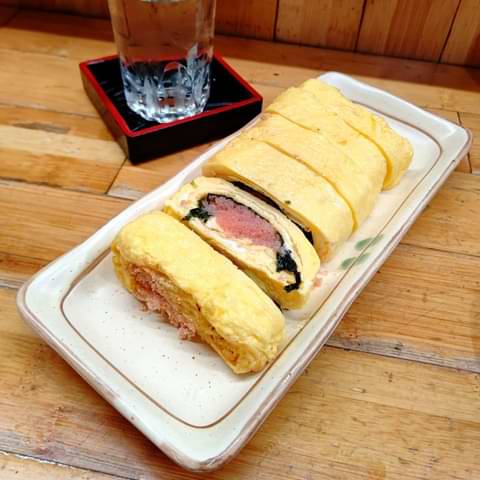
Dinner at the yatai
The yatai of Fukuoka are small mobile restaurants open from 18:00 to 02:00 at night (except for bad weather days) and allow you to enjoy excellent street food in the typical atmosphere that they can give their customers: a few seats and the family atmosphere of a dinner at the counter where it is not uncommon to meet to toast with the Japanese present.
One of the typical foods of yatai are grilled chicken skewers (yakitori), although under this name pork, vegetable and seafood skewers are often included. Other street foods include yaki-gyōza and oden, the broth pot that contains boiled eggs, fried tofu and daikon.
In Fukuoka the yatai are mainly found in three areas such as the modern one of Tenjin, that of Nagahama famous for its “Nagahama rāmen” with ultra thin spaghetti, and that of Nakasu, the most characteristic and loved by tourists with its about 20 yatai located along the bank of the Naka-gawa River.
In total there are about 100 yatai where you can enjoy their delicious street food: there is really plenty to choose from!
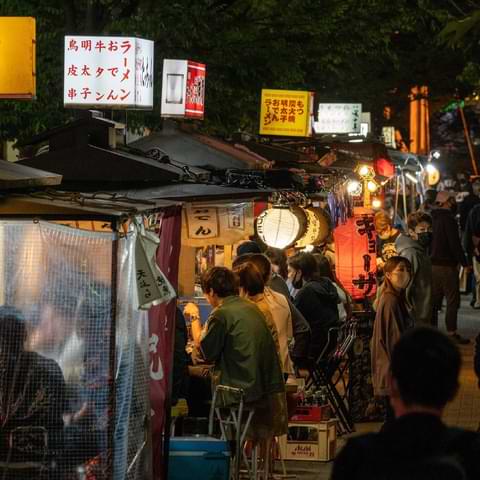
Useful links
Day 13 - Fukuoka
Itinerary of the day
Photo gallery
Typical products and souvenirs
Mizutaki 水炊き
The mizutaki is a variant of nabemono typical of Hakata with more than 100 years of history. The name comes from Mizu, water, and taki, simmer. As the name suggests, it is a hot dish in which ingredients such as chicken, mushrooms and vegetables, are cooked in water or dashi broth.
Typically cooked at the table on a gas stove, the meat is dipped in ponzu sauce or in yuzu koshō paste before being savored. Only at the end, consumed all the meat, add the previously cooked noodles to the hot soup.
In the city, Hakata Hanamidori is a restaurant specializing in mizutaki that uses first-class products. This particular nabemono is still considered the traditional dish of the Hakata Gion Yamakasa Matsuri.

Hakata-ningyō 博多人形
Hakata-ningyō are traditional terracotta dolls with bright colors and elegant details, originating from the city of Fukuoka and renowned throughout Japan as exceptional examples of Japanese aesthetic beauty. The history of these dolls dates back to about 800 years ago, when the people of Hakata already had the custom of worshipping unglazed ceramic dolls.
Examples of Hakata-ningyō were shown with great success at the 1890 “Exposition Universelle de Paris”, and after that the demand for these dolls increased dramatically worldwide. Today, this illustrious tradition continues to thrive through the works of nearly 100 Hakata-ningyō producers.
These dolls, which reproduce various subjects such as women in kimono, sumo wrestlers, kabuki and nō actors, children, animals and seasonal festivals, are also celebrated during a holiday dedicated to them, the Hakata Gion Yamakasa Matsuri, during which the characteristic allegorical floats are decorated with these dolls.
In the city, as well as in souvenir shops of traditional crafts, you can buy them in dedicated stores, such as Hakata-ningyō Shōgetsu-dō, one of the largest Hakata-ningyō stores that also offers workshops for painting your doll.
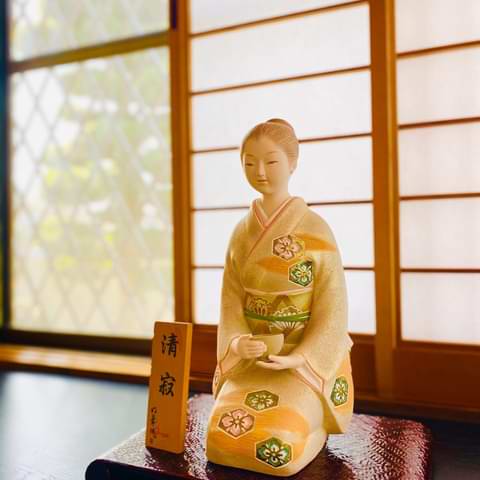
Hakata-magemono 博多曲物
Magemono, or local handicrafts made of hinoki wood, were originally produced exclusively for use as instruments in the sacred rites of Hakozaki Hachiman-gū, one of the three main Hachiman-gū shrines in Japan. Later they were used more and more widely, leading to the realization of objects for the tea ceremony as well as for daily use, such as containers for rice and boxes for lunch.
In the making of these objects, hinoki wooden slats are soaked in water to become more ductile. Once the boards are quite soft, they are folded with a machine and then assembled by sewing the interlocking with the elegant bark of birch or Japanese cherry.
These souvenirs are really appreciated, and often you will also find finely painted and decorated versions. At the historic Hakata Magemono and Shibata Toku Shōten you can find all kinds of items, with really wonderful decorations!
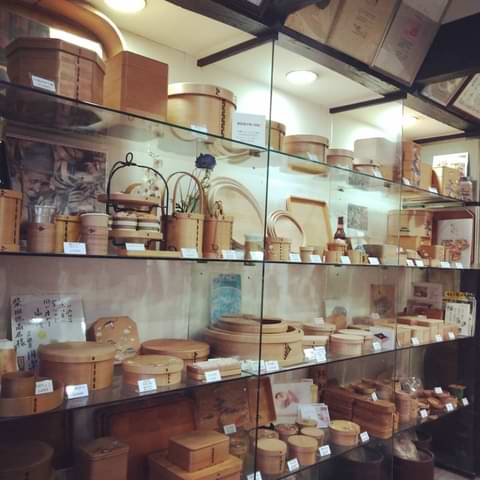
Hakata-ori 博多織
Hakata-ori is a thick, resistant and thick-woven fabric with ancient origins and still used for the production of obi for kimono and yukata, but also accessories such as bags, ties, key chains, book holders, fans etc.
The fabrics are produced using silk threads, metallic fiber and Japanese silk twine along with gold foils, silver foils and lacquered leaves. The typical pattern of the fabrics is called kenjō-gara and is found in tile art at JR Hakata station and other places in the city.
There are two varieties of Hakata-ori: kenjō, which involves the use of fabrics of only five colors and is characterized by the traditional kenjō-gara geometric motif related to Buddhism, and the mon-ori, containing multi-colored designs.
The production process of these fabrics is complex and divided into five phases, each of which carried out by different specialized artisans. Although artisans are flanked by mechanized systems, much of the work is still done by traditional manual weaving machinery.
Shops such as Hakata Japan sell Hakata-ori accessories and clothing, while some of the city’s craft centers such as the important Hakata Machiya museum display and sell traditional products, as well as showing the processes of realization with the original machinery.
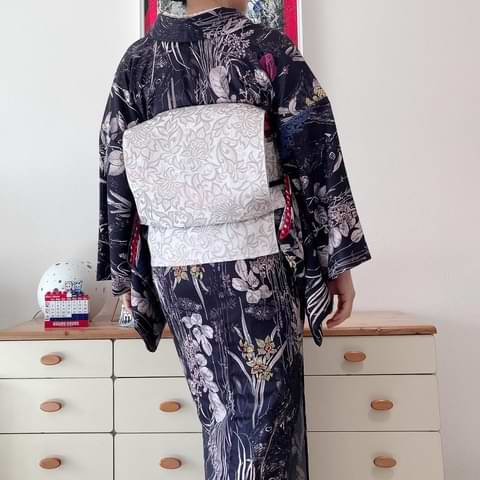
Tetsunabe-gyōza 鉄鍋餃子
Yaki-gyōza are a variant of Fukuoka cooking of gyōza, a Japanese version of Chinese jiaozi dumplings. They differ from the latter mainly by the rich flavor of garlic and the dough of the dumplings thinner. They are often stuffed with minced meat, cabbage, chives and garlic and are accompanied by soy sauce and wasabi.
In Fukuoka they have become a speciality thanks to the grilling. With this cooking the ravioli are first made crunchy on the flat side, and then, through the use of a lid, finished steaming. In the city they are called tetsunabe-gyōza because they are served on hot iron plates, tetsunabe.
Gyōza in this style can be found in specialty shops around the city, especially around JR Hakata station, but also at izakaya, yatai, such as Hide Chan, or rāmen bars such as Kurume Honda-shōten, inside Rāmen Stadium.

Useful links
We really hope that reading is thrilling you!
If so, we would be very grateful if you could leave a star rating or a short review to the book on amazon, not having a publishing house behind it would be of great help!
Also, don’t hesitate to let us know your impressions on Instagram and Facebook using the hashtag #fourseasonsinjapan or by tagging @cuor.di.manju in your posts/stories.
Day 14 - Kyōto
Itinerary of the day
Photo gallery
Typical products and souvenirs
Kyō-gashi 京菓子
Kyōto is famous for keeping Japanese history alive, and there is nothing more traditional than the tea ceremony, in which maccha tea is served accompanied by small and artistic treats called wagashi.
In Kyōto these sweets are a real cult, so much so that they are called Kyō-Gashi. The bakeries compete in creating the most refined and detailed sweets to entertain their customers visually.
Some of these bakeries offer the opportunity to participate in the preparation of these desserts through special experiences, such as Kanshundō.
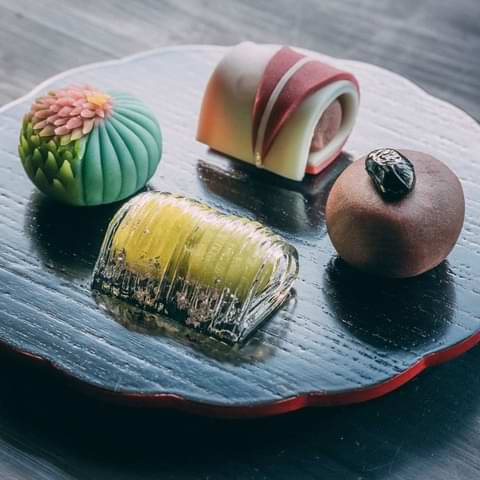
Uji-cha 宇治茶
The Uji region, south of Kyōto, is one of the prefecture’s largest producers of green tea, supplying the ancient capital with high-quality tea called Uji-cha. The most famous types of Uji-cha are the maccha powder, used for the tea ceremony, the gyokuro, that is the first harvest of the year with leaves grown in the shade instead of under the full sun, and the sencha, the classic green tea.
In the city of Kyoto tea shops can be found almost everywhere. In addition to the old quarter of Kiyomizu, the shopping area between Nishiki-Ichiba Market and Shijō-dōri Street has many shops selling Uji-cha tea, as well as accessories such as containers, teapots etc. Among them Harada has a wide assortment of cups and teapots of all manufactures and materials.
The area of Wazuka has several crops including Obubu, a community that promotes this local product selling it online and offering experiences of harvesting and tours through their fields.
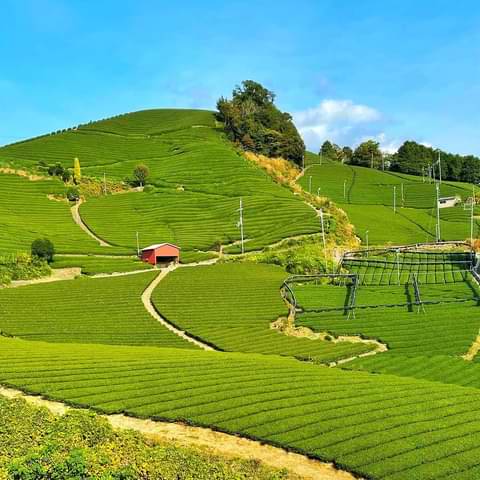
Chazutsu 茶筒
Chazutsu is a metal container, usually cylindrical in shape, used to store tea leaves. It is an essential and everyday tool in Japanese homes as the quality, aroma and taste of tea tend to deteriorate due to sunlight, moisture and oxygen.
With time, the function of preserving tea has been joined by the aesthetic aspect transforming these containers into real objects of furniture. While the inside remains in metal, the outside can be covered with different materials: from elegant wood, often finely decorated with gold or hand-painted leaves, to washi paper or cloth, two materials that, thanks to the infinite patterns and colors available, have allowed the spread of this product as an accessory or simple souvenir.
Kyōto offers a myriad of shops that sell these containers, many of which also sell tea. On Shijō-dōri Street there are many, among them the beautiful shop ALBA offers many different types.
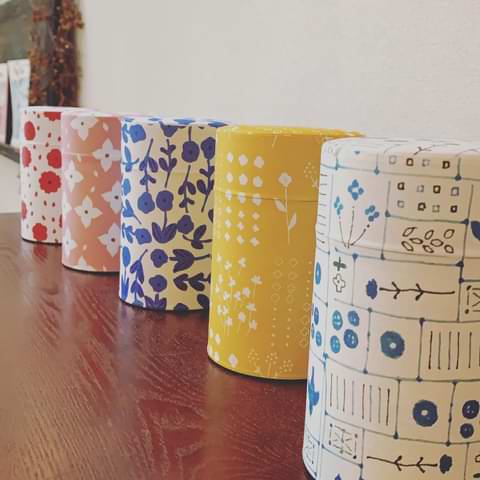
Tsukemono 漬物
Tsukemono, literally “things in brine”, are vegetables preserved in salt or vinegar, or fermented using rice bran, miso or soy sauce. They are usually served as a snack, with meals to accompany the main courses or even in the various mini-courses of the kaiseki kitchen.
These products are typical of the vegetarian Buddhist diet, the shōjin-ryōri, and are rich in properties that promote the immune system.
These foods are now part of the cuisine of the country and are also offered in the traditional Japanese breakfast. The most common vegetables to find like tsukemono are daikon, cucumber, eggplant, carrot, cabbage, ginger, onion and umeboshi plums.
Typical in Kyōto are purple pickles such as shibazuke, a pickle made from cucumber or eggplant, and senmaizuke, thin slices of crispy turnip.
Also worth mentioning are the saikyōzuke, preserved cod slices and marinated in miso paste that, at the time of eating, are grilled and served hot. The fish preserved in this way takes on a sweet and caramelized taste thanks to miso.
Walking through the Nishiki-Ichiba market, many shops offer these specialties to be eaten fresh or given as a souvenir.
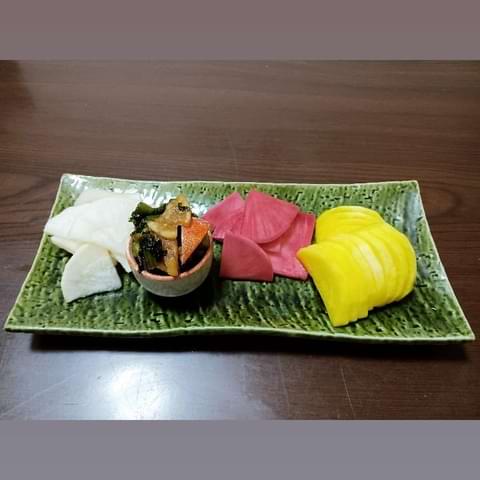
Saba-zushi 鯖寿司
Sabazushi consists of single portions of rice covered with marinated mackerel and wrapped in sheets of pickled konbu seaweed, all pressed in special molds. The mackerel is filleted and the fillets are then marinated in rice vinegar and sugar for a short time. Then the outer skin is carefully removed while maintaining the thin inner layer.
The origin of this specialty is linked to Kyoto’s remoteness from the sea, as the conservation of many fish, such as mackerel, was entrusted to methods such as salt and vinegar during the journey to the city. Over the centuries, this extremely nutritious dish has been preserved to this day becoming the most famous type of sushi in the city.
In Kyoto, all sushi restaurants serve this specialty, and some historic eateries such as Izuu specialize in different variations of the dish, even to take away. Further north, it’s worth a visit to Hanaore Honten, a shop selling mackerel and other marinated fish under vacuum.
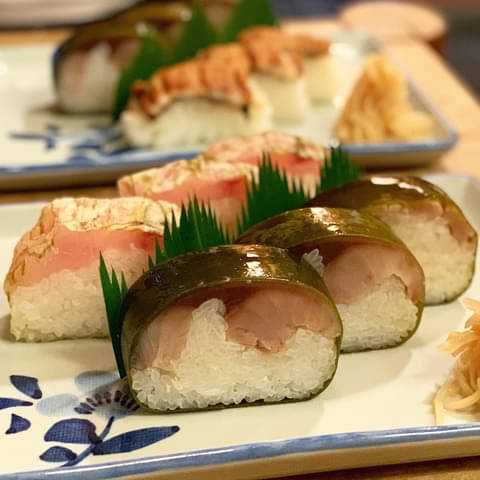
Furoshiki 風呂敷
Furoshiki are square cloth cloths used by the Japanese to store or transport objects. If in the past they were used to wrap the bentō boxes, the typical Japanese packed lunch, today they are widely used as real bags and passing bags, as well as wrapping for gifts.
The first furoshiki fabrics were the Tsutsumi, literally “casing”, used to protect the objects to be brought to the temples. Then, with the increase in public toilets, these cloths became known as furoshiki (furo=bath and shiki=unfold), as they facilitated the transport and change of clothes in bathrooms by preventing mixing with those of others.
Today, thanks to the sustainability of the fabric compared to plastic bags, these accessories are back in fashion as real items of clothing, thanks to the beautiful patterns that embellish them.
In Kyōto, where the tradition of fabrics is very much felt, you can find classic furoshiki hand-painted or in bags version for all tastes. Along the Sanjō-dōri shopping street is Kyōto Musubi, a large shop specializing in furoshiki of all kinds and imaginations. If you prefer small craft shops, then Gotō Saburō-shōten is for you!
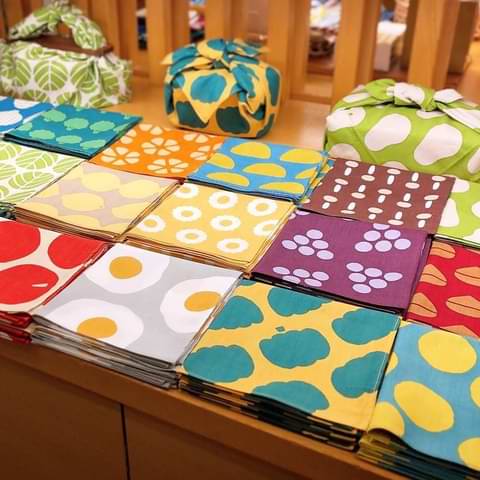
Tenugui 手拭い
In addition to the tissues used as clothing around the neck or the bag, the tenugui, soft, long fabrics of thin cotton printed or painted by hand, are really widespread. Once used as towels, today they have become real furnishing elements to be framed as paintings, with subjects that vary from stylized patterns to traditional scenes, but also enchanting designs related to the seasons and nature.
In the chain of shops of Eirakuya, which has several outlets throughout the city, you will find an infinity of these magnificent fabrics, a lightweight souvenir that will not take up much space in the suitcase.
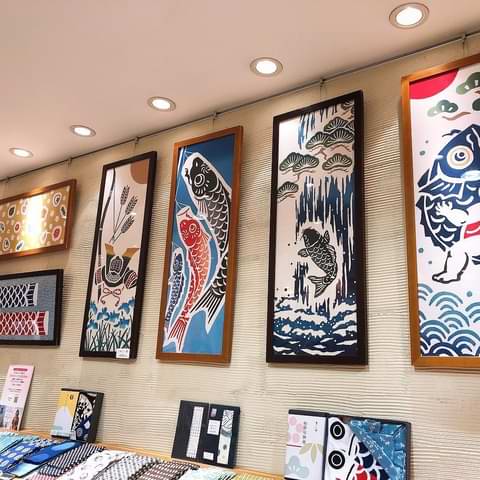
Handicraft markets
Every weekend and on fixed dates of the month, hundreds of stands are set up at temples and sanctuaries in nature where small local artisans sell their handmade products.
Stands of wallets, handbags, clothing or home accessories made from Japanese fabrics, but also stalls displaying creations and objects in a variety of materials, are flanked by those of food prepared by the locals, Handcrafted treats made with care, teas and other products from local activities.
If you visit Kyōto, it’s recommended to spend just half an hour inside one of these markets that sell out-of-the-ordinary souvenirs and truly unique. Onigiro has collected the most famous markets in his guide to the monthly markets in Kyōto.
